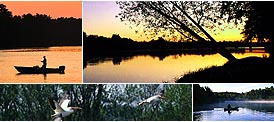


Wildlife Information
Alligators
Black Bear
Whooping Crane
Bald Eagle
Manatee
Florida Panther
Brown Pelican
Florida Wildlife - Manatee
Christopher Columbus was the first European to report seeing a manatee in the New World. To Columbus, and other sailors who had been at sea for a long time, manatees were reminiscent of mermaids -- the mythical half-fish, half-woman creatures of the ocean. Manatees are not fish, however, but marine mammals.
The West Indian or Florida manatee (and sometimes called sea cow) is found primarily along the coast of Florida. Most adult manatees are about 10 feet long and weigh 800 to 1,200 pounds, although some larger than 12 feet and weighing as much as 3,500 pounds have been recorded. These "gentle giants" have a tough, wrinkled brown-to-gray skin that is continuously being sloughed off. Hair is distributed sparsely over the body. With stiff whiskers around its mouth, the manatee's face looks like a walrus without tusks. The manatee maneuvers through the water moving its paddle- like tail up and down and steering with its flippers. It is very agile for such a large animal, sometimes somer-saulting and doing barrel rolls in the water. The manatee often rests suspended just below the water's surface with only the snout above water. It feeds underwater, but must surface periodically to breath. Although the manatee can remain underwater for as long as 12 minutes, the average time is 4 1/2 minutes. Manatees are herbivores, meaning they eat only plants. But they eat a great variety of aquatic plant species, including water hyacinth and hydrilla. Manatees must eat 4 to 9 percent of their body weight each day. That's at least 32 pounds of plants per day for an 800-pound manatee! To do this, they spend 5 to 8 hours a day eating. Manatees spend their lives moving between freshwater, brackish, and saltwater environments. They prefer large, slow- moving rivers, river mouths, and shallow coastal areas such as coves and bays. Great distances may be covered as the animals migrate between winter and summer grounds. During the winter, manatees congregate around warm springs and power plants that discharge warm water. During summer months, they have occasionally been seen as far north as Virginia and Maryland. Manatees reach breeding maturity between 3 and 10 years of age. The gestation period is approximately 13 months. Calves may be born at any time during the year. Usually only one calf is born, but twins do occur. Newborn calves weigh 60 to 70 pounds and are 4 to 4 1/2 feet long. They nurse underwater for about 3 minutes at a time from a nipple located behind their mother's forelimb. Born with teeth, calves begin eating plants within a few weeks but remain with their mother for up to 2 years. Manatees communicate with each other by emitting sounds underwater that are audible to humans. The vocalizations, which sound like squeaks and squeals, are especially important for maintaining contact between mother and calf. One field report described a mother and her calf, separated by a flood gate, calling to each other for 3 hours without interruption until they were reunited. Historically, manatees were hunted for the flesh, bones, and hide by Native Americans and later by the early colonists. Manatee fat was used for lamp oil, bones were used for medicinal purposes, and the hide for leather. This hunting is thought to be largely responsible for the manatee's initial decline. Natural events also imperil the lives of manatees. In 1977, 1981, 1984, and 1989, unusually cold winters lowered water temperatures throughout Florida, killing many manatees, which cannot survive long in cold water. As the water temperature drops below 60 degrees º, manatees become sluggish and stop eating. Young manatees are especially susceptible to the effects of cold temperatures. Periodic red tide blooms have also been associated with a number of manatee deaths. Red tide toxins accumulate in sea squirts which adhere to sea grasses. This poison is ingested incidentally by manatees feeding on sea grasses. But the largest problems facing the manatee are caused by man. Speeding boats run over many manatees that are submerged just below the surface, killing them either by impact with the boat itself or by slicing into their backs with the propellers. Manatees that survive such encounters carry distinctive scars (in fact, biologists studying the manatee use the scars as ways of identifying individual manatees). Many areas now post speed- limit signs for boaters, or prohibit them completely in areas heavily populated by manatees. Flood gates and canal locks have accidentally killed manatees either by crushing or drowning them, although modifications of operating procedures have reduced the number of fatalities from this source. Fishing line and other trash discarded into the water are also responsible for a small number of manatee deaths each year. Death may result if the manatee's digestive tract becomes blocked by fishing line accidentally eaten. Fishing line may also become tightly wound around a flipper, creating serious infection, amputation, or at worst, death. Harassment from skin divers, fishermen, and boaters can interrupt feeding and mating activities. During the winter, manatees may be driven into cooler water where they are more susceptible to disease and cold stress. The manatee has difficulty rebounding from these threats because of its late breeding maturity and its low reproductive rate. In general, the birth rate is not able to keep up with those manatees killed by boats. Manatee population counts are usually conducted from airplanes. It is difficult to obtain an exact population figure because poor weather or murky water conditions make it difficult to clearly see the manatees. In 1992, 1,856 manatees were counted by aerial surveys conducted throughout the manatee's range. Biologists use radio tracking to study individual manatees, locate and assess habitat use areas, and learn about migratory patterns. As long ago as 1893, Florida passed a law to protect manatees. Since 1907, there has been a $500 fine for any person who kills or harms a manatee. In 1978, Florida designated the entire state as a "refuge and sanctuary for the manatees" through the Florida Manatee Sanctuary Act. This law allows the State of Florida to designate manatee sanctuaries and establish speed zones for boats. At the Crystal River National Wildlife Refuge on Florida's West Coast, boats are required to reduce their speed and, during the winter when manatees congregate, boats, swimmers, and divers are prohibited in certain areas. The manatee was listed as an endangered species in 1967 (under a law that preceded the Endangered Species Act of 1973), meaning it is considered in danger of extinction throughout all or a significant portion of its range. The manatee also is protected at the federal level under the Marine Mammal Protection Act of 1972. A vital component of the U.S. Fish and Wildlife Service's recovery efforts for the manatee is increasing public awareness and cooperation among boaters, skin divers, fishermen, and anyone else using the rivers and coastal waters where manatees live. With growing awareness and positive action, the manatee can be saved for generations to come.
Information provided by:
Fish and Wildlife Service
















